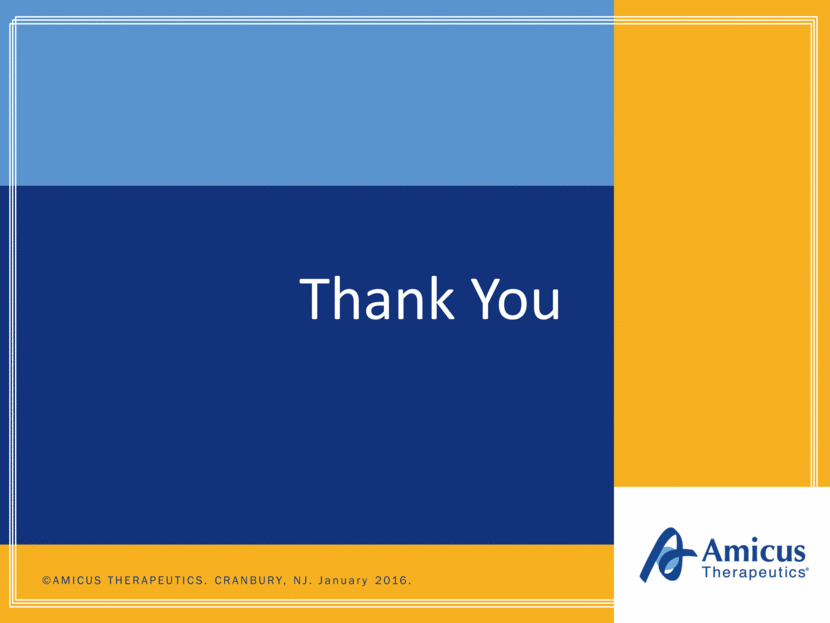Attached files
| file | filename |
|---|---|
| 8-K - 8-K - AMICUS THERAPEUTICS, INC. | a16-1606_18k.htm |
| EX-99.1 - EX-99.1 - AMICUS THERAPEUTICS, INC. | a16-1606_1ex99d1.htm |
| EX-99.3 - EX-99.3 - AMICUS THERAPEUTICS, INC. | a16-1606_1ex99d3.htm |
Exhibit 99.2
34th Annual J.P. Morgan Healthcare Conference John F. Crowley, Chairman and Chief Executive Officer January 12, 2016
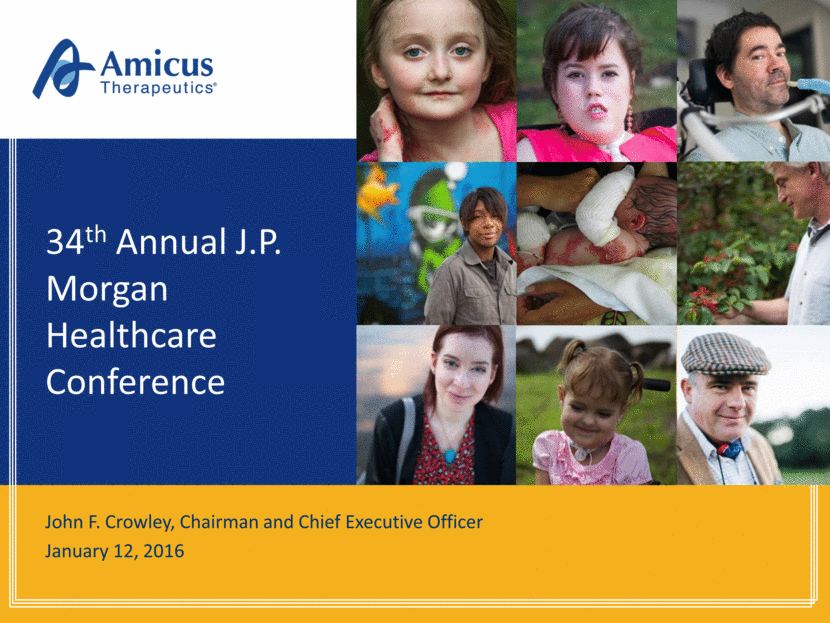
Safe Harbor This presentation will contain, “forward-looking statements” within the meaning of the Private Securities Litigation Reform Act of 1995 relating to preclinical and clinical development of Amicus’ candidate drug products, the timing and reporting of results from preclinical studies and clinical trials evaluating Amicus’ candidate drug products, financing plans, and the projected cash position for the Company. Words such as, but not limited to, “look forward to,” “believe,” “expect,” “anticipate,” “estimate,” “intend,” “potential,” “plan,” “targets,” “likely,” “may,” “will,” “would,” “should” and “could,” and similar expressions or words identify forward-looking statements. Such forward-looking statements are based upon current expectations that involve risks, changes in circumstances, assumptions and uncertainties. The inclusion of forward-looking statements should not be regarded as a representation by Amicus that any of its plans will be achieved. Any or all of the forward-looking statements in this press release may turn out to be wrong. They can be affected by inaccurate assumptions Amicus might make or by known or unknown risks and uncertainties. For example, with respect to statements regarding the goals, progress, timing and outcomes of discussions with regulatory authorities, and in particular the timing of an NDA submission for migalastat monotherapy, and the potential goals, progress, timing and results of preclinical studies and clinical trials, actual results may differ materially from those set forth in this release due to the risks and uncertainties inherent in the business of Amicus, including, without limitation: the potential that results of clinical or pre-clinical studies indicate that the product candidates are unsafe or ineffective; the potential that it may be difficult to enroll patients in our clinical trials; the potential that regulatory authorities may not grant or may delay approval for our product candidates; the potential that preclinical and clinical studies could be delayed because we identify serious side effects or other safety issues; the potential that we will need additional funding to complete all of our studies and, our dependence on third parties in the conduct of our clinical studies. Further, the results of earlier preclinical studies and/or clinical trials may not be predictive of future results. With respect to statements regarding projections of the Company’s cash position, actual results may differ based on market factors and the Company’s ability to execute its operational and budget plans. In addition, all forward looking statements are subject to other risks detailed in our Annual Report on Form 10-K for the year ended December 31, 2014 and Form 10-Q for the quarter ended June 30, 2015. You are cautioned not to place undue reliance on these forward-looking statements, which speak only as of the date hereof. All forward-looking statements are qualified in their entirety by this cautionary statement, and Amicus undertakes no obligation to revise or update this news release to reflect events or circumstances after the date hereof. This caution is made under the safe harbor provisions of Section 21E of the Private Securities Litigation Reform Act of 1995. 2 Introduction
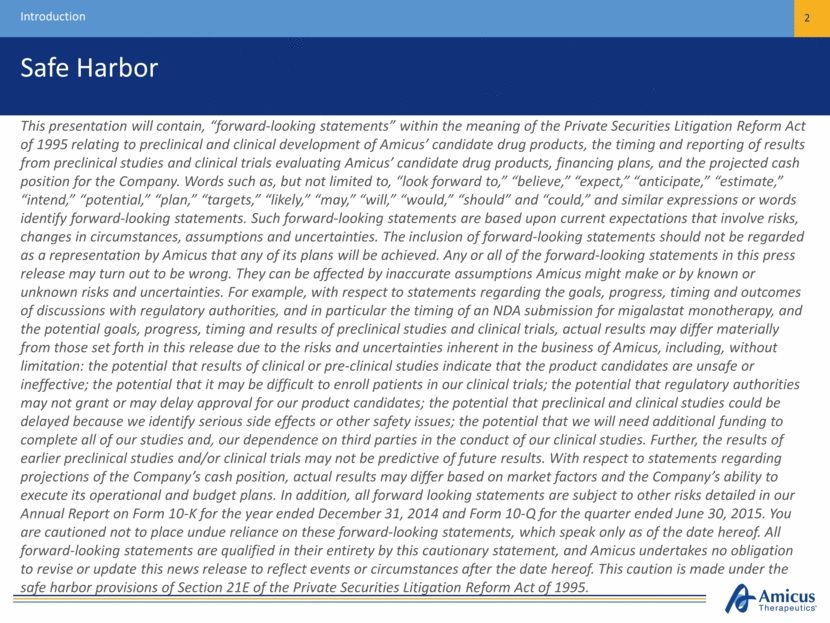
Amicus 2016 – Looking Back 3 Introduction Chaperone Technology for LSDs Small molecules US rights to migalastat Callidus acquisition Biologics Global rights to migalastat Positive Phase 3 data for migalastat Biologics scale up International HQ MAA Submission Scioderm acquisition Pompe ERT in clinic Amicus Has Greatly Expanded Product Pipeline, Technologies and Geographies 2012 2013 2014 2015

Amicus 2016 – Continuing the Momentum 4 Introduction CHMP opinion for migalastat for Fabry FDA regulatory clarity for migalastat EB Phase 3 data Pompe clinical data 2016 Anticipated Milestones Chaperone Technology for LSDs Small molecules US rights to migalastat Callidus acquisition Biologics Global rights to migalastat Positive Phase 3 data for migalastat Biologics scale up International HQ MAA Submission Scioderm acquisition Pompe ERT in clinic Significant Milestones in 2016 2012 2013 2014 2015
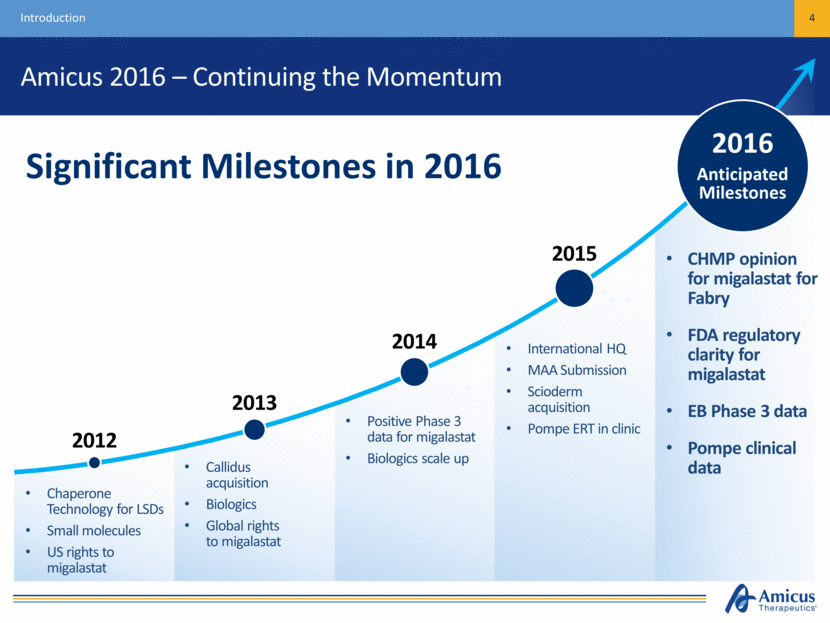
Amicus Vision Introduction 5 Amicus Therapeutics is a global biotechnology company at the forefront of developing advanced therapies to treat a range of devastating rare and orphan diseases Potential First-in-Class / Best-in-Class Meaningful benefits for patients Rare & Devastating Diseases

Key Drivers of Value Introduction 6 3 Novel Product Candidates Each with $500M to $1B+ Market Potential Migalastat Personalized Medicine (Small Molecule) MAA Submitted CHMP Opinion Anticipated Early 2016 Prepared for EU Launch* Phase 3 Novel Topical Cream (SD-101) U.S. Breakthrough Therapy Designation Rolling NDA Phase 3 Data Expected in 2H16 Novel ERT + Chaperone Treatment Paradigm Biologics Manufacturing Clinical Study Initiated with Data Anticipated in 2016 R&D Engine and Continued Business Development Activity Pompe Epidermolysis Bullosa (EB) Fabry *Pending Approval

Migalastat Personalized Medicine for Fabry Disease
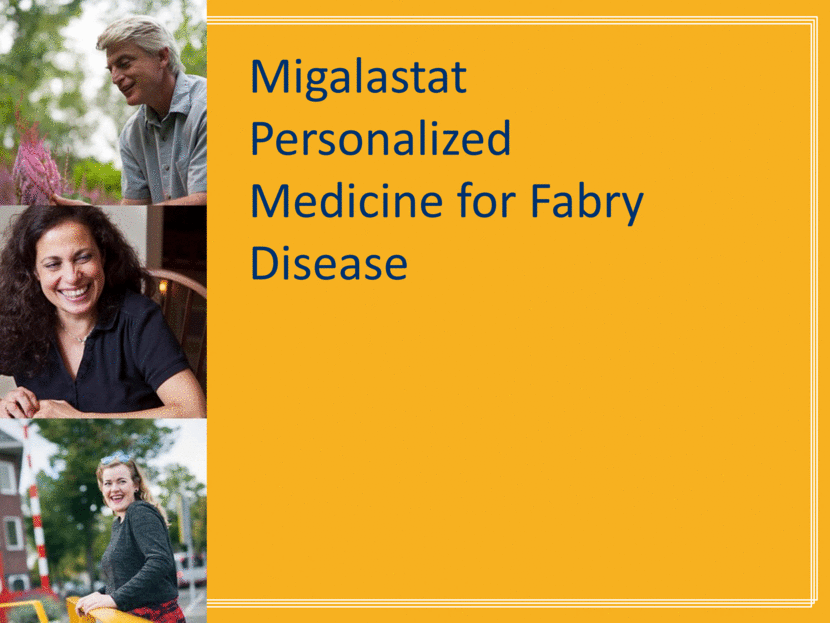
Fabry Disease Overview – For Meetings Migalastat: Potential Personalized Medicine for Fabry Disease 8 Fabry Disease is a Fatal Genetic Disorder that Affects Multiple Organ Systems Leading Causes of Death Life-Limiting Symptoms TRANSIENT ISCHEMIC ATTACK (TIA) & STROKE1 KIDNEY DISEASE3 Protein in the urine Decreased kidney function Kidney failure HEART DISEASE2 Irregular heartbeat (fast or slow) Heart attack or heart failure Enlarged heart GASTROINTESTINAL3 Nausea, vomiting, cramping, and diarrhea Pain/bloating after eating, feeling full Constipation Difficulty managing weight Deficiency of α-Gal A enzyme leading to GL-3 accumulation >800 known mutations 5-10K diagnosed WW (51% female/49% male4) Newborn screening studies suggest prevalence of ~1:1000 to ~1:4000 Key Facts 1. Desnick R, et al. Ann Intern Med. 2003 2. Yousef Z, et al. Eur Heart J. 2013 3. Germain D. Orphanet J Rare Dis. 2010 4. Fabry Registry 2011

Fabry Disease Overview – For Podium Migalastat: Potential Personalized Medicine for Fabry Disease 9 Fabry Disease is a Fatal Genetic Disorder that Affects Multiple Organ Systems Leading Causes of Death Life-Limiting Symptoms TRANSIENT ISCHEMIC ATTACK (TIA) & STROKE1 KIDNEY DISEASE3 HEART DISEASE2 GASTROINTESTINAL3 1. Desnick R, et al. Ann Intern Med. 2003 2. Yousef Z, et al. Eur Heart J. 2013 3. Germain D. Orphanet J Rare Dis. 2010 4. Fabry Registry 2011 Deficiency of α-Gal A enzyme leading to GL-3 accumulation >800 known mutations 5-10K diagnosed WW (51% female/49% male4) Newborn screening studies suggest prevalence of ~1:1000 to ~1:4000 Key Facts
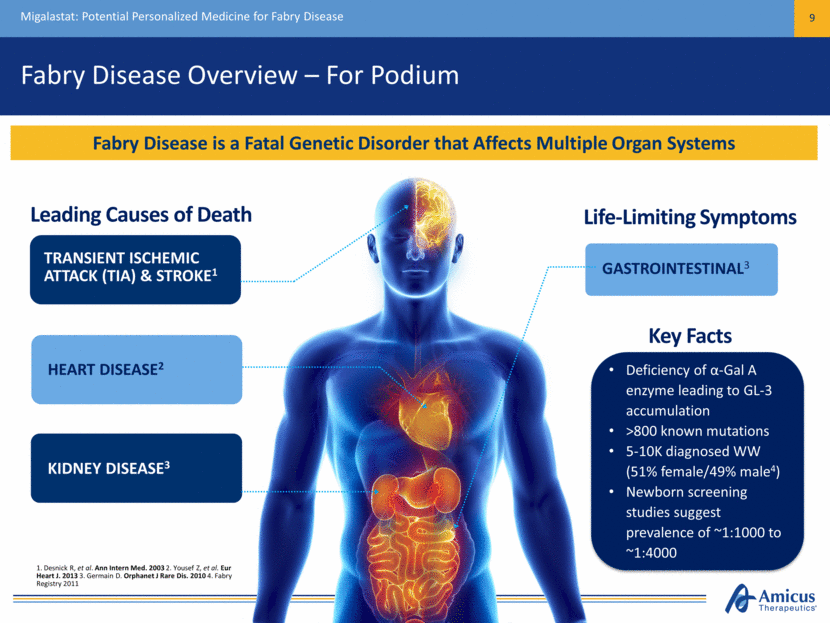
Summary of Clinical Data Migalastat: Potential Personalized Medicine for Fabry Disease 10 Favorable Efficacy and Safety Data in Two Largest Phase 3 Studies Ever Completed in Fabry Disease 1: Stabilization from baseline over 18 months with favorable comparison to natural history in literature 2: Comparable to ERT over 18 months 3: Improvement from baseline over 18+ months 4: Improvement versus placebo over 6 months in amenable patients Reduction in Cardiac Mass Left Ventricular Mass Index (LVMI) (Study 0113 and 012) Improvement in GI Symptoms Gastrointestinal Symptoms Rating Scale (GSRS) (Study 0114) Reduction in Disease Substrate IC GL-3 (Study 0114) Plasma Lyso Gb-3 (Study 0113,4 and 0122) Low Rate of Fabry-Associated Clinical Events Renal, Cardiac and Cerebro-Vascular Events (Study 0122) Stability of Kidney Function Estimated Glomerular Filtration Rate (eGFR) and measured GFR (Study 0111 and Study 0121,2)
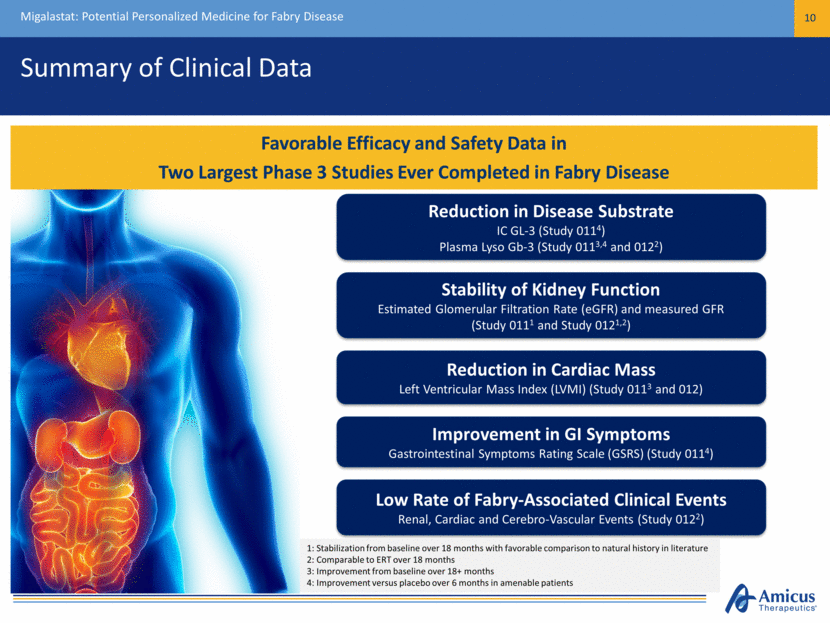
Additional Phase 3 Data on Diarrhea Symptoms Migalastat: Potential Personalized Medicine for Fabry Disease 11 Migalastat has Generated Promising Data on Diarrhea Improvement, One of the Most Life-Limiting Symptoms of Fabry Disease Note: Month 6 used as baseline for patients in placebo arm switching to migalastat; MID from Chan 2006 in kidney transplant. Minimal important difference (MID) for the GSRS diarrhea domain is 0.4 (Chan 2006, renal transplant patients) Baseline Symptoms Change from Baseline to Month 6 Placebo Migalastat Statistically Significant Change - Migalastat vs. Placebo from Baseline to Month 6 (nominal p=0.026) NEW -3 -2 -1 0 1 2 3 1 2 3 4 5 6 7

Fabry Patient Perspective Migalastat: Potential Personalized Medicine for Fabry Disease 12 Case Report from Long-Term Treatment with Migalastat Shows Improvement in Pain and Return to Everyday Activities1 1. Schiffmann, et al. Nine-year follow-up in a patient receiving migalastat pharmacological chaperone therapy for Fabry disease. SSIEM 2015. Enzyme activity increased Cardiac and renal functions remained normal Phase 2 Study + OLE for 4.5 Years Phase 3 OLE for 4.5 Years (Still Ongoing) Paresthesias and sensation of stiffness improved Feels well, goes to gym and works Discontinued pain medication Patient Journey to Diagnosis Chronic pain Weakness and fatigue Pain medication
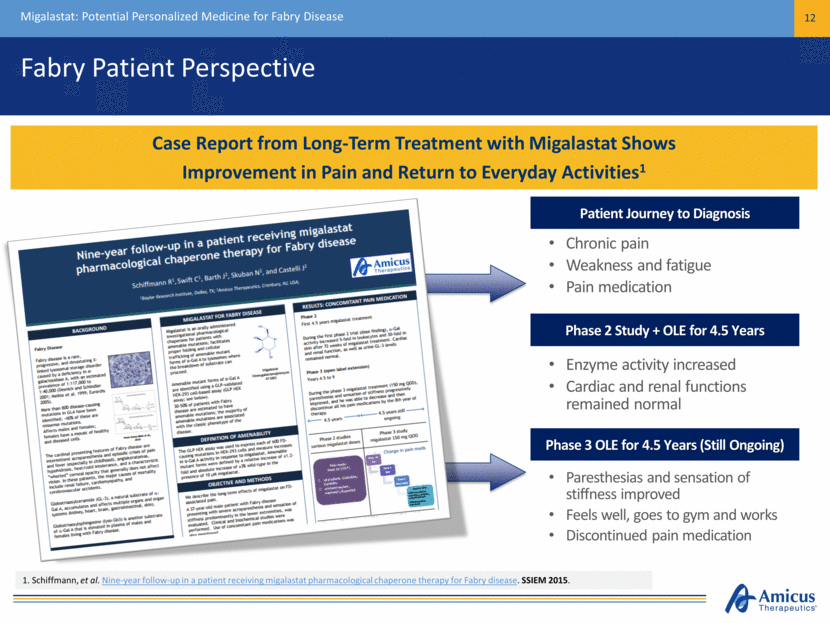
Global Regulatory Strategy Migalastat: Potential Personalized Medicine for Fabry Disease 13 FDA Update on Regulatory Status Expected in 1Q16 CHMP Opinion Expected Early 2016 Plan to Submit Regulatory Approvals in Other Key Geographies EU Approval Will Lay the Foundation to Address ~70% of Global Fabry Market

Fabry Market Today Migalastat: Potential Personalized Medicine for Fabry Disease 14 Migalastat has Potential to Offer a Number of Important “Firsts” for Fabry Patients $1.1B in FY14 ERT Sales1 1. Company filings and Amicus estimates 40-50% of Diagnosed Patients Not on ERT Today Market Continues to Grow > 10% / Year ERT Infused Once Every 2 Weeks First new product in > 10 years First oral therapy First targeted therapy for amenable patients (30%-50% of population) U.S. 27% EU 34% Rest of World 39% Hard Capsules Oral Use 14 Hard Capsules
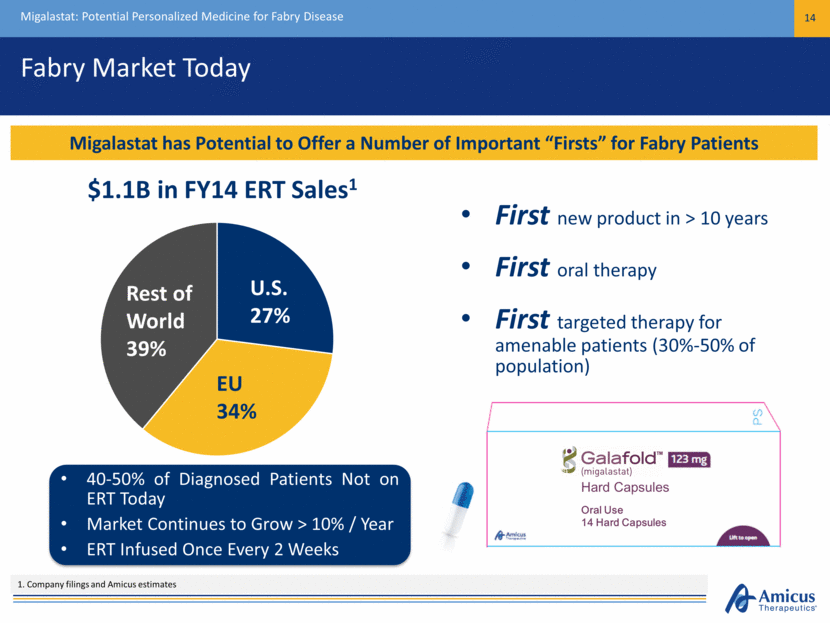
Global Infrastructure and International Team Migalastat: Potential Personalized Medicine for Fabry Disease 15 World-Class Global Commercial Team to Support Migalastat Launch Upon Regulatory Approvals with Further Expansion in 2016 Global HQ Germany UK/Intl. HQ France Netherlands
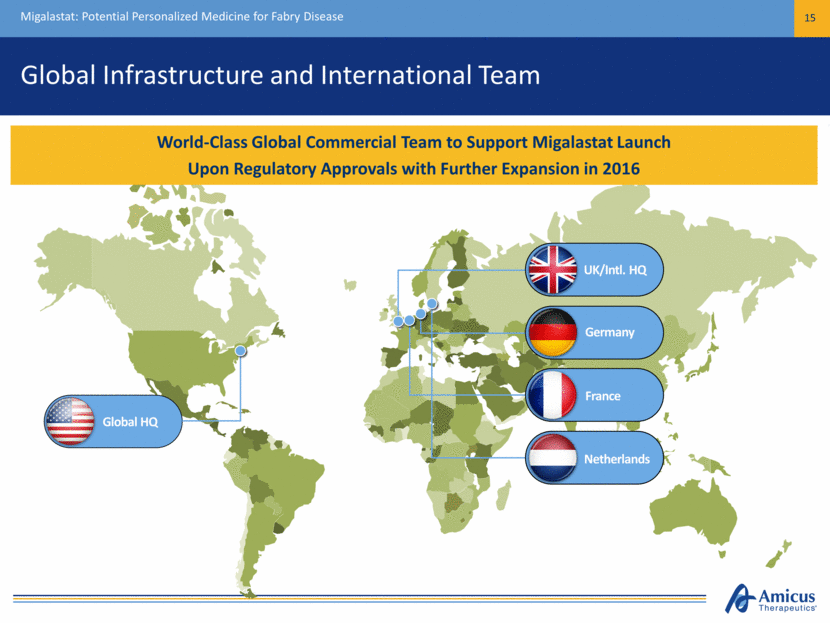
Global Infrastructure and International Team Migalastat: Potential Personalized Medicine for Fabry Disease 16 World-Class Global Commercial Team to Support Migalastat Launch Upon Regulatory Approvals with Further Expansion in 2016 Global HQ Germany UK/Intl. HQ France Netherlands
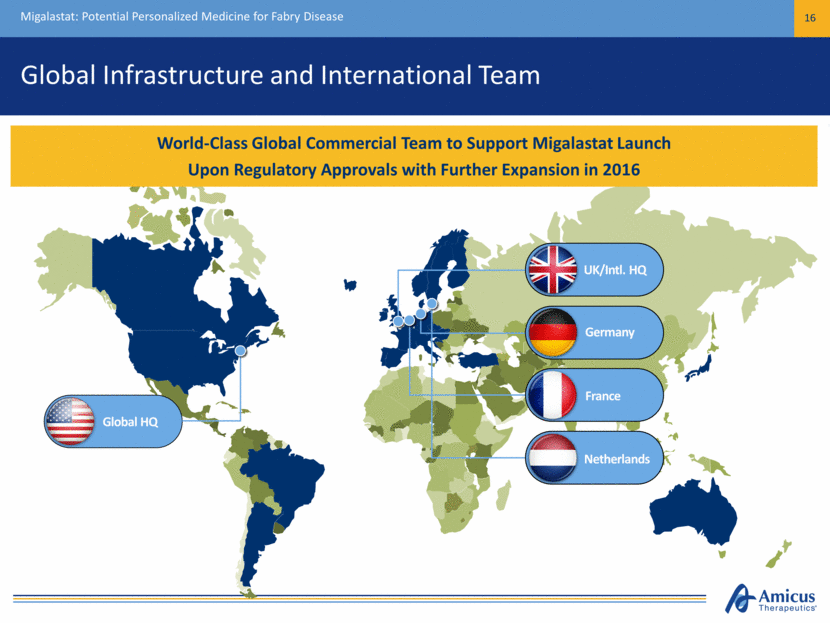
Commercial Launch Preparation Activities 17 Migalastat: Potential Personalized Medicine for Fabry Disease Experienced commercial leadership team with established international operations International distribution system Medical education and patient advocacy ongoing on behalf of Fabry patients Global value dossier complete and local submissions in development Amicus is Preparing for Potential Launches in 2016 Patient and physician mapping
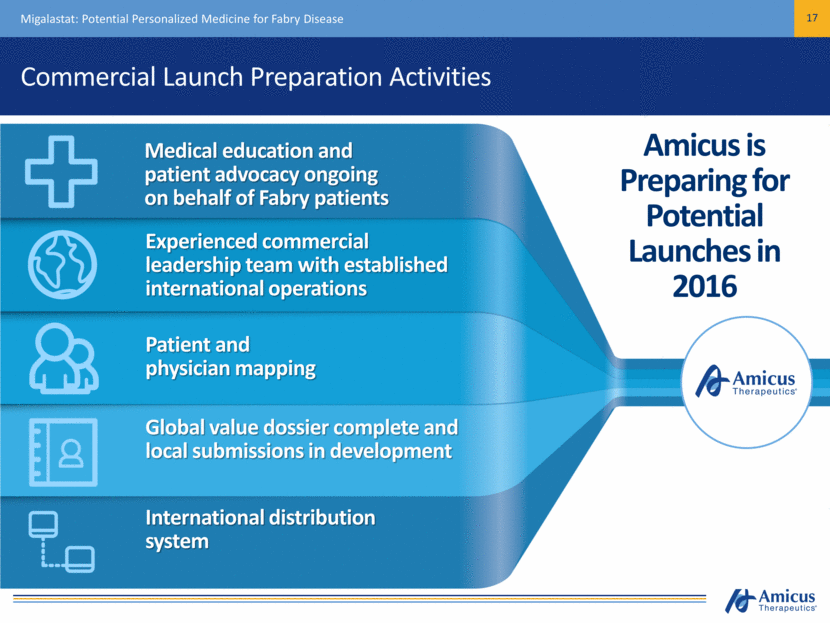
SD-101 for Epidermolysis Bullosa (EB) Poised to deliver pivotal data for a devastating rare disease in 2016

EB Disease Overview SD-101 for EB 19 Rare, Devastating, Connective Tissue Disorder with No Approved Treatments Multiple genes cause disease which results in fragility of skin and can affect internal organs Diagnosed from infancy to adulthood Severe blistering, open wounds and scarring in response to minor friction to the skin Disfiguring, excruciatingly painful, and can be fatal Given the lack of approved treatment options, any reduction in disease symptoms would be considered meaningful 30,000 – 40,000 diagnosed patients in major global regions

Three Major EB Subtypes Represent ~99% of EB Population SD-101 for EB 20 No Approved Therapies Today SD-101 in Development for All 3 Major Subtypes 30,000-40,000+ Diagnosed in Major Markets INCREASING SEVERITY Multiple Subtypes Single Devastating and Fatal Genetic Disorder Simplex Dystrophic Junctional ~75% of EB Population ~20% of EB Population ~5% of EB Population

U.S. Breakthrough Therapy Designation Open-label, 8 patient proof-of-concept study1 Ages 6 months – 9 years All baseline target wounds ≥ 10 cm2 SD-101 3% applied once daily for 3 months SD-101 for EB 21 Positive Early Results from Phase 2a Study Led to Breakthrough Therapy Designation 1. Simplex (n=3), Junctional (n=3), Recessive Dystrophic (n=2) Key Findings 1-Year-Old Girl with EB Simplex Baseline Following 2 months of treatment 87.5% of patients experienced complete closure of target wounds within 1 month Daily administration generally safe and well-tolerated 57% reduction in affected body surface area by month 3
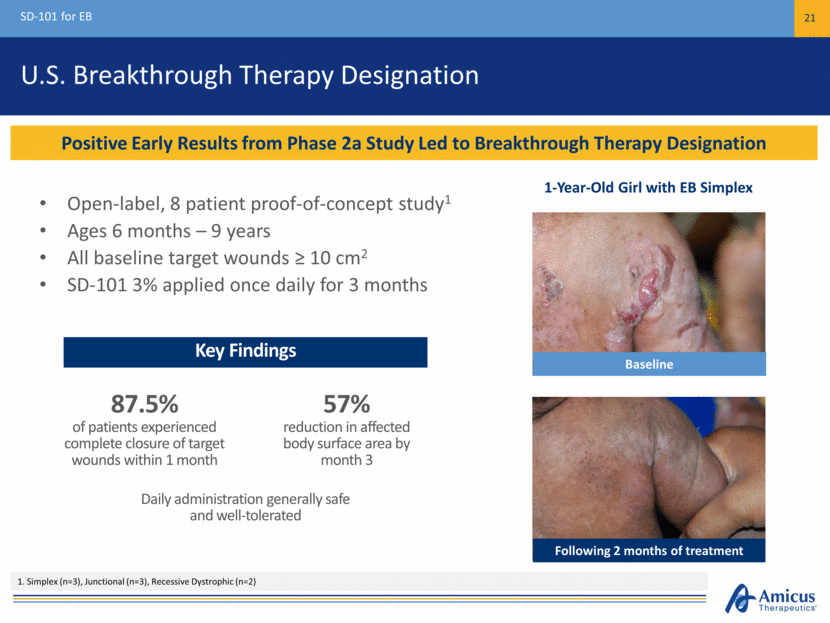
Phase 2b Design (Study 003) SD-101 for EB 22 Placebo (n=17) SD-101 6% (n=15) Open-Label Zorblisa (6%) 3-Month Double-Blind Treatment Period1 Primary Efficacy Endpoint: Target Wound Healing at Month 1 Baseline wound: Chronic (≥ 21 days), size 5-50 cm2 SD-101 3% (n=16) Secondary Efficacy Endpoints Include: Time to target wound closure Change in Body Surface Area (BSA) of lesional skin 42/44 Patients entered extension study $400K FDA Grant for Extension Study 48 EB patients (age ≥ 6 months)1 - 1:1:1 Randomization - Daily Topical Application 1. Assessments: 0, 14, 30, 60, 90 Days. 2. Initial Disease Severity: Mean target lesion size (cm2) 14.0 (range 5-39); mean lesional BSA: 19.4% (range 0.4-48%); mean wound age (days): 182 (range 21-1,639). EB Subtypes enrolled: Simplex (n=11), Recessive Dystrophic (n=29), and Junctional (n=8) Optional Extension (SD-004)
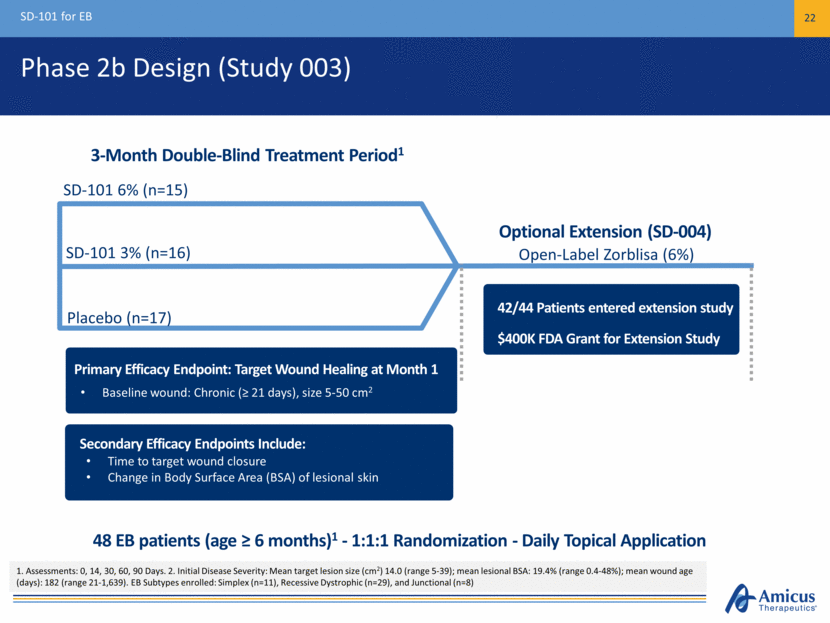
Phase 2b Results SD-101 for EB 23 SD-101 6% Demonstrated Higher Proportion of Complete Target Wound Closure *SD-101 6% vs placebo, unadjusted p=0.04 ITT Population (n=48) Evaluable Population1 (n=45) (p=0.04)* Proportion of Complete Target Wound Closure (%) Proportion of Complete Target Wound Closure (%) 1. Excluded from Evaluable population: 1 patient (due to lost to follow-up), 2 patients (did not have single identified and qualified target lesion). 1 additional patient lost to follow up after Month 1 visit and is excluded from target wound assessment at later time points N=17 N=15 N=16 N=17 N=15 N=16 N=17 N=12 N=16 N=17 N=11 N=16 Placebo SD-101 3% SD-101 6% 41% 41% 38% 44% 67% 82% Month 1 Month 2 (Pre-specified Primary Endpoint) (Phase 3 Primary Endpoint) 41% 41% 38% 44% 53% 60% Month 1 Month 2 (Pre-specified Primary Endpoint) (Phase 3 Primary Endpoint)

Phase 2b Results – Secondary Endpoint SD-101 for EB 24 SD-101 6% Showed Fastest Time to Wound Closure; SD-101 Generally Safe and Well-Tolerated Median Time to Wound Closure (Days) Median Time to Wound Closure (Days) 91 Days 86 Days 40 Days ITT Population (n=48) Evaluable Population (n=45) Adverse Events Similar Across Treatment Arms of Placebo, SD-101 3%, and SD-101 6% Placebo SD-101 3% SD-101 6% 91 Days 86 Days 30 Days N=17 N=15 N=16 N=17 N=12 N=16
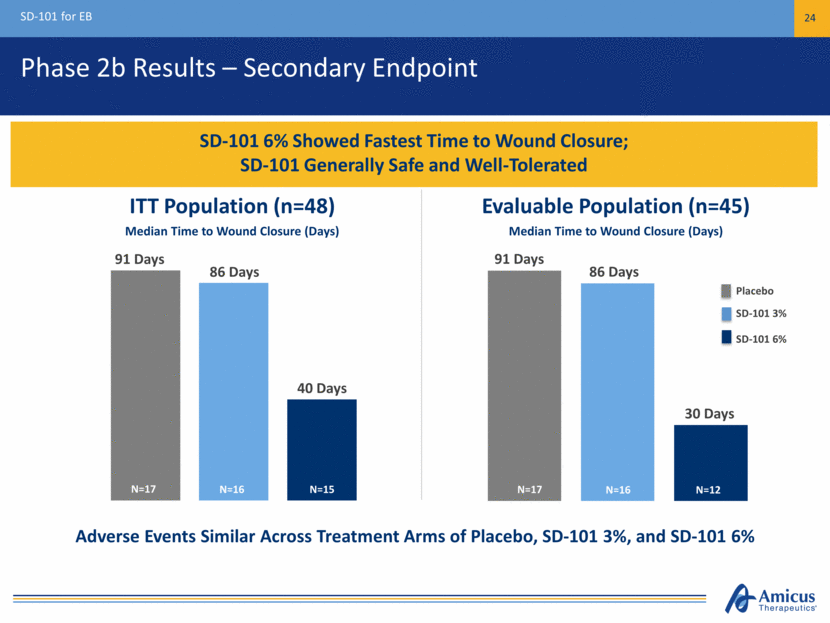
Phase 2b Extension (Study 004) Results SD-101 for EB 25 Results on Total Body Surface Area (BSA) Affected by Wounds and Lesions Mean Absolute Change to Month 12 (95% CI): -3.41% (-7.0, 0.2) BL n=42 M3 n=37 M6 n=33 M9 n=30 M12 n=28 Note: Mean and SEM on change from baseline are plotted. Study 004 Total BSA baseline values are: N=42 Baseline population: 11.3. N=28 population used for Month 12 comparison: 10.9 Mean Relative Change to Month 12 (95% CI): -12.92% (-37.8, 11.9) 3 6 9 12 -5 -4 -3 -2 -1 0 1 2 3 Baseline Time, Months C h a n g e i n T o t a l B S A f r o m B a s e l i n e ( % )
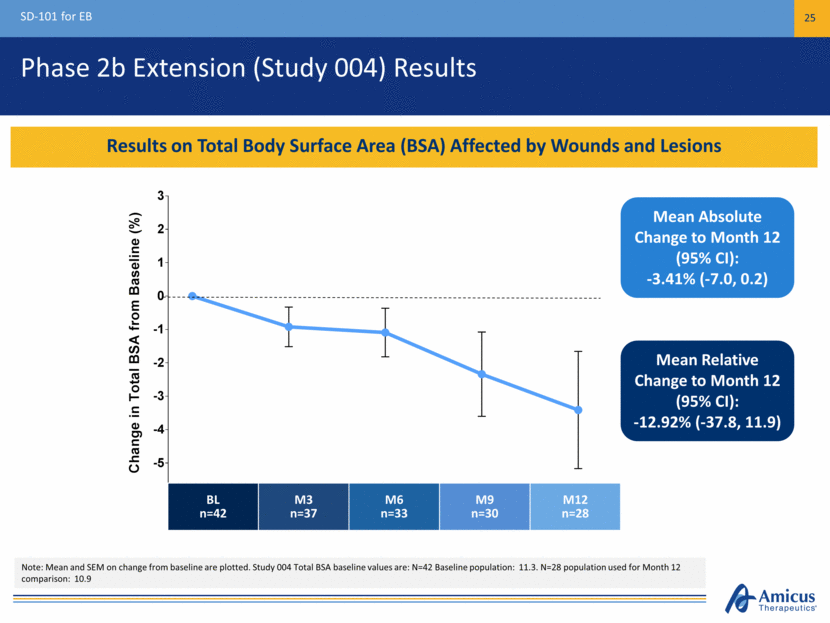
Phase 3 Design (SD-005) SD-101 for EB 26 Phase 3 Initiated in 2Q15 and ~50% Enrolled Top-Line Data Expected 2H16 ~150 EB patients (age ≥ 1 month) Placebo SD-101 6% Primary Endpoint: Target Wound Healing at Month 2 US and EU regulatory authorities agreed on primary endpoint Baseline wound: Chronic (≥ 21 days), size ≥10 cm2 44/44 Patients Have Continued in Open-Label Extension (Jan. 8, 2015) Primary Endpoint: Target Wound Healing at Month 2 US and EU regulatory authorities agreed on primary endpoint Baseline wound: Chronic (≥ 21 days), size ≥10 cm2 Primary Endpoint: Target Wound Healing at Month 2 US and EU regulatory authorities agreed on primary endpoint Baseline wound: Chronic (≥ 21 days), size ≥10 cm2 Secondary Endpoints Include Time to target wound closure Change in Body Surface Area (BSA) of lesions and blisters 3-Month Double-Blind Treatment Period1 Open-Label Zorblisa (6%) Optional Extension (SD-006) 1. Assessments: 0, 14, 30, 60, 90 Days. 1:1 randomization, daily topical application
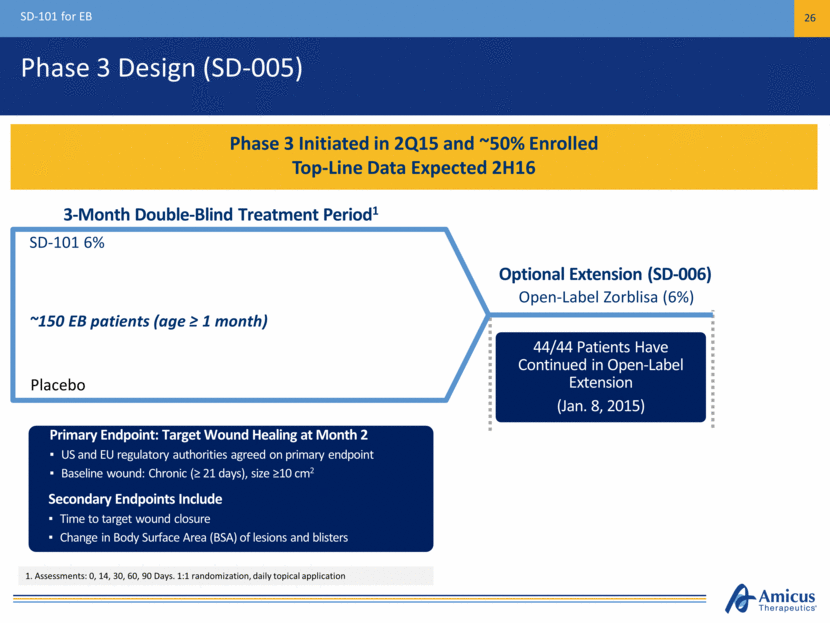
Phase 3 Design (SD-005) SD-101 for EB 27 Study Design Incorporates Key Learnings from Phase 2b Study ~150 EB patients (age ≥ 1 month) Placebo SD-101 6% Primary Endpoint: Target Wound Healing at Month 2 US and EU regulatory authorities agreed on primary endpoint Baseline wound: Chronic (≥ 21 days), size ≥10 cm2 44/44 Patients Have Continued in Open-Label Extension (Jan. 8, 2015) Sample Size (p ≤ 0.05 if treatment difference ~17% or greater) Optimal concentration 1. Complete target wound closure in patients with target wounds ≥ 10 cm2 at Month 2 in Phase 2b: SD-101 6% - 50% (n= 4) vs. Placebo - 12.5% (n=8) Primary Endpoint: Target Wound Healing at Month 2 US and EU regulatory authorities agreed on primary endpoint Baseline wound: Chronic (≥ 21 days), size ≥10 cm2 Primary Endpoint: Target Wound Healing at Month 2 US and EU regulatory authorities agreed on primary endpoint Baseline wound: Chronic (≥ 21 days), size ≥10 cm2 Secondary Endpoints Include Time to target wound closure Change in Body Surface Area (BSA) of lesions and blisters Increases Ability to Distinguish SD-101 vs. Placebo1 3-Month Double-Blind Treatment Period Open-Label Zorblisa (6%) Optional Extension (SD-006)
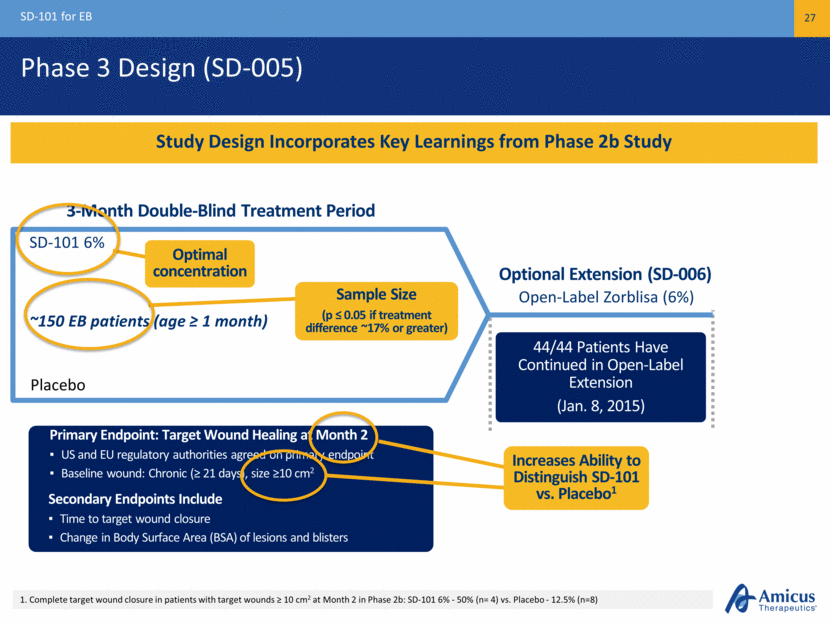
Global Regulatory Strategy SD-101 for EB 28 Positive FDA and EMA Feedback on Phase 3 Study Design U.S. Breakthrough Therapy Designation (BTD) based on Phase 2 POC U.S. Orphan drug designation Rolling NDA initiated 4Q15 EU Orphan drug designation Approved Pediatric Investigation Plan (PIP) Defined regulatory pathway ROW regulatory strategy based on EMA and FDA submissions
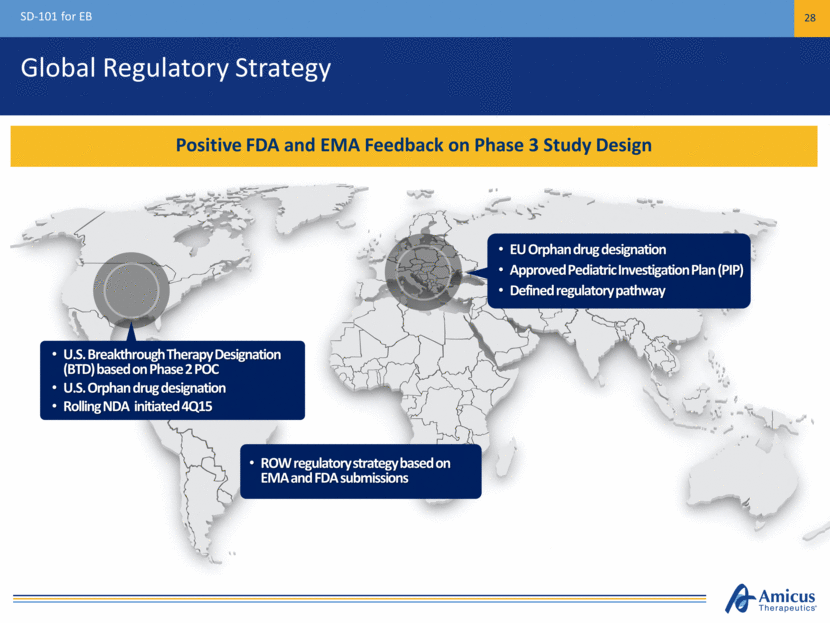
$1B+ Commercial Potential SD-101 for EB 29 KOL Feedback Supports Profound Unmet Medical Need and Broad Usage in All EB Subtypes Diagnosed EB Patients by Geography Significant Unmet Medical Need Significant Unmet Clinical Need No approved treatments, opportunity for first-in-class Promising proof-of-concept in all EB subtypes Strong Support Among Surveyed Stakeholders Physicians indicate usage in 100% patients Payers indicate support for broad reimbursement if approved Large Commercial Opportunity 30,000 – 40,000 diagnosed patients in major markets KOLs expect diagnosis rates to increase (US, EU3, Japan) U.S. 52% EU3 35% Japan 13%
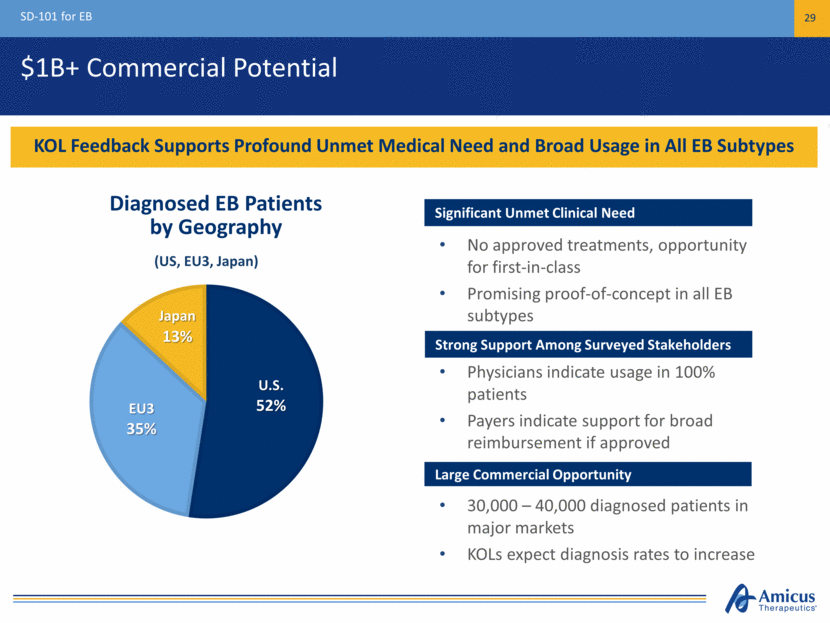
ATB200 Novel ERT for Pompe Disease A Proprietary, Clinical-Stage Biologics Program

Pompe Disease Overview Novel ERT for Pompe Disease – ATB200 + Chaperone 31 Severe, Fatal Genetic Disorder with Significant Unmet Medical Need Deficiency of GAA leading to glycogen accumulation Age of onset ranges from infancy to adulthood Symptoms include muscle weakness, respiratory failure and cardiomyopathy Respiratory and cardiac failure are leading causes of morbidity and mortality 5,000 – 10,000 patients diagnosed WW1 ~$700M+ Global Pompe ERT sales in FY142 1. National Institute of Neurological Disorders and Stroke (NIH). 2. Sanofi Press Release & 10-K
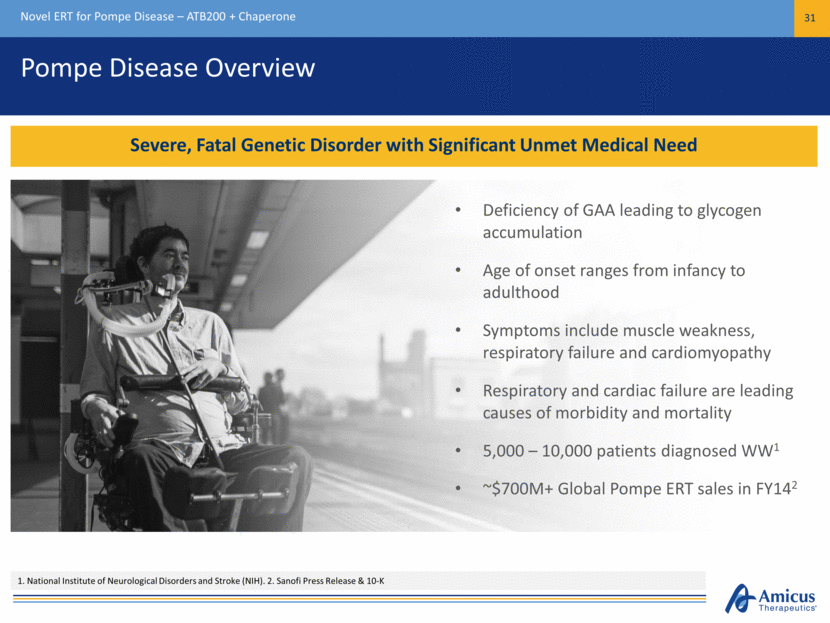
Pompe Patient Perspectives Novel ERT for Pompe Disease – ATB200 + Chaperone 32 Very Significant Unmet Need Despite Availability of Currently Marketed Therapy
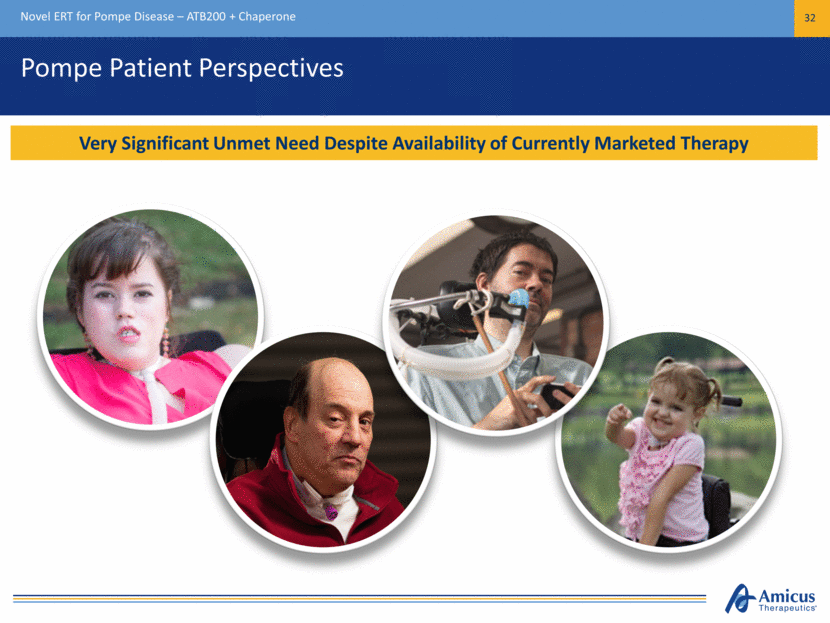
Pompe ERT - 3 Challenges Novel ERT for Pompe Disease – ATB200 + Chaperone 33 Activity/ Stability Rapid denaturation of ERT in pH of blood1 Tolerability / Immunogenicity Infusion-associated reactions in >50% of late-onset patients3 Uptake/ Targeting Low M6P receptor uptake into skeletal muscle2 Antibody titers shown to affect treatment outcomes4,5 Vast majority of rhGAA not delivered to lysosomes2 Protein Aggregation 1Khanna et al., PLoS ONE, 2012; 2Zhu et al., Amer. Soc. Gene Therapy, 2009 June; 3Banati et al., Muscle Nerve, 2011 Dec.; 4Banugaria et al., Gen. Med., 2011 Aug.; 5de Vries et al., Mol Genet Metab., 2010 Dec. Amicus Technology Platforms with Potential to Address Challenges with Existing Pompe ERT Uniquely Engineered rhGAA Optimized M6P & Carbohydrates
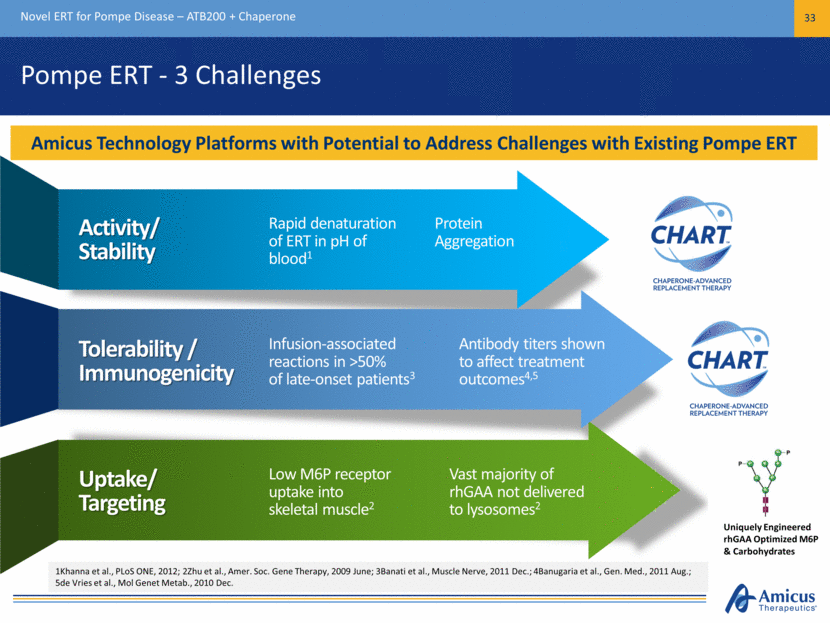
Preclinical Proof-of-Concept Novel ERT for Pompe Disease – ATB200 + Chaperone 34 ATB200 + Chaperone Results in Improved Substrate Clearance in Preclinical Models1 Untreated Alglucosidase Alfa ATB200 + AT2221 Wild Type PAS (20x) Untreated Alglucosidase Alfa ATB200 +AT2221 Wild Type LAMP1 (40x) 1. Following 2 doses of 20mg/kg alglucosidase alfa or ATB200 + AT2221 in Gaa KO mice, skeletal muscles evaluated for glycogen clearance and proliferated lysosomes. Treatment with alglucosidase alfa modestly reduced glycogen or proliferated lysosomes while ATB200, co-administered with AT2221 significantly decreased the muscle pathology associated with Pompe disease PAS-glycogen staining in Quadriceps LAMP1 Immunohistochemical staining in Soleus

Biologics Manufacturing Capabilities Novel ERT for Pompe Disease – ATB200 + Chaperone 35 Optimized Glycosylation and Key Quality Attributes Maintained Through Scale Up rhGAA lacks M6P; cannot be targeted to lysosomes rhGAA contains M6P; targeted to lysosomes Lyophilized Vial of ATB200 GAA Activity (nmol/mL/hr) GAA Activity (nmol/mL/hr) GAA Activity (nmol/mL/hr) M6P [mM] M6P [mM] M6P [mM] CI-MPR Receptor Chromatography GAA Activity M6P Bench Scale 5L Scale 250L Scale Proof of Concept Studies 0 20 40 60 80 0 1 2 3 4 5 8% 92% G A A A c t i v i t y ( n m o l / m L / h r ) M 6 P [ m M ] 0 15 30 45 60 0 1 2 3 4 5 5L Bioreactor Run G A A A c t i v i t y ( n m o l / m L / h r ) M 6 P [ m M ] GAA Activity M6P (mM) 11% 89% 0 20 40 60 80 0 1 2 3 4 5 Engineering Run 2 G A A A c t i v i t y ( n m o l / m L / h r ) M 6 P [ m M ] 9% 91%
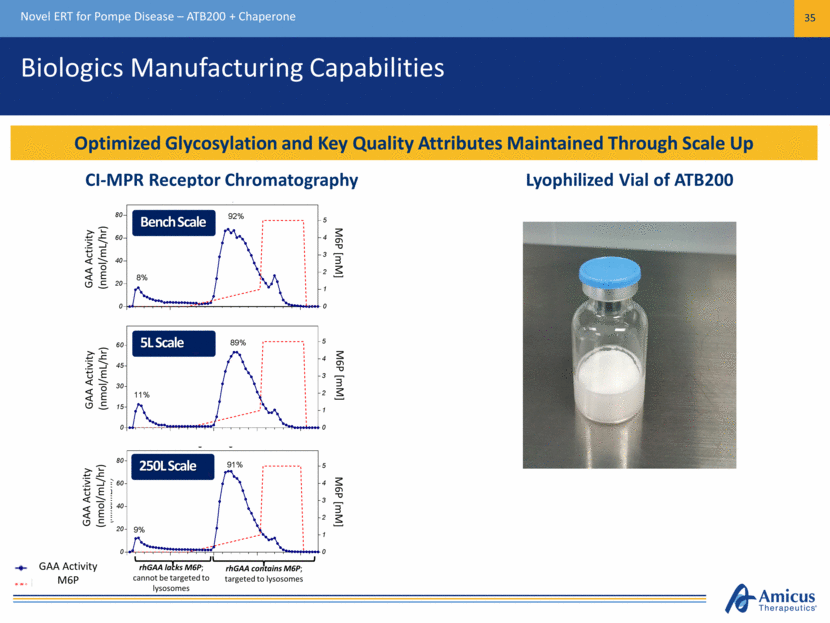
Clinical Study in Pompe Patients Novel ERT for Pompe Disease – ATB200 + Chaperone 36 Study Design Supported by US and EU Regulators Stage 2 (Multiple Ascending Dose) ATB200 20mg/kg + AT2221 (Low Dose) 3 doses ATB200 20mg/kg + AT2221 (High Dose) 3 doses ATB200 5 mg/kg Stage 1 (Single Ascending Dose) Single Dose ATB200 Every Other Week Fixed Dose ATB200 + Chaperone (AT2221) Every Other Week Long-Term Open Label Extension Fixed Dose ATB200 + Chaperone (AT2221) Every Other Week Assessments: Plasma PK (Enzyme Activity & Total protein) Safety/Tolerability Antibodies Infusion-Associated Reactions Pharmacodynamics (OLE) ATB200 20 mg/kg ATB200 10 mg/kg
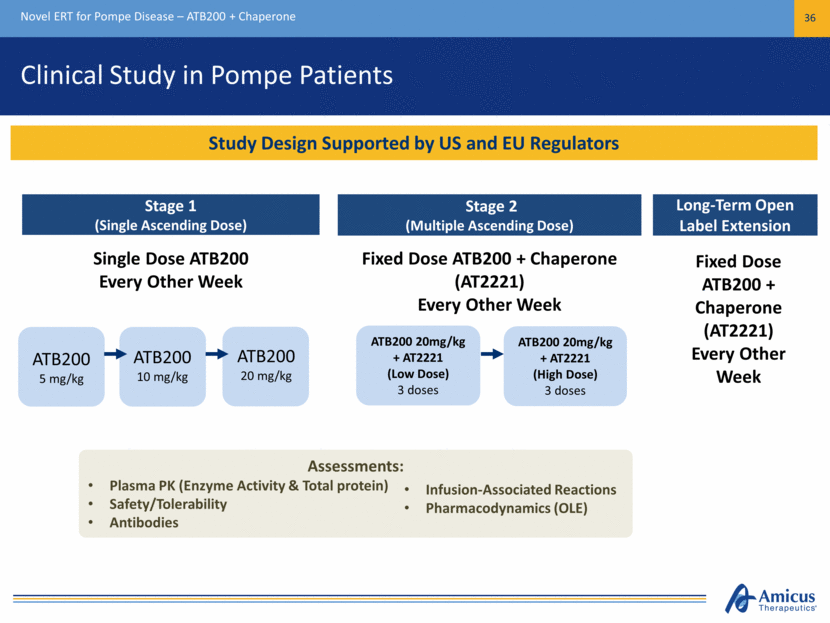
Financial Summary Strong Balance Sheet to Invest in Rare Disease Pipeline
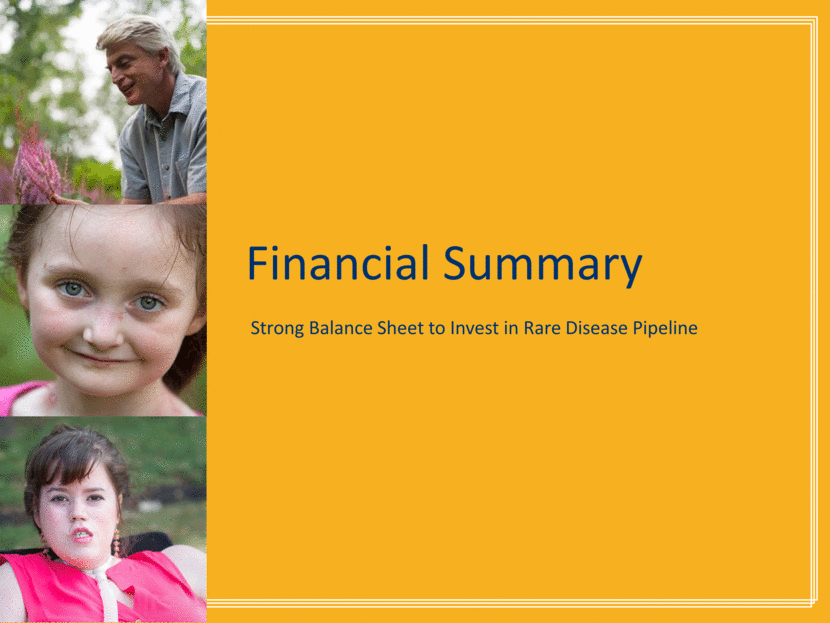
Strong Balance Sheet Financial Summary 38 Financial Position December 31, 2015 Current Cash: $214M Current Debt $50M FY16 Net Cash Spend Guidance: $135M-$155M Cash Runway Mid-2017 Capitalization Shares Outstanding 125,027,034 Cash Position Provides Runway Under Current Operating Plan into 1H17
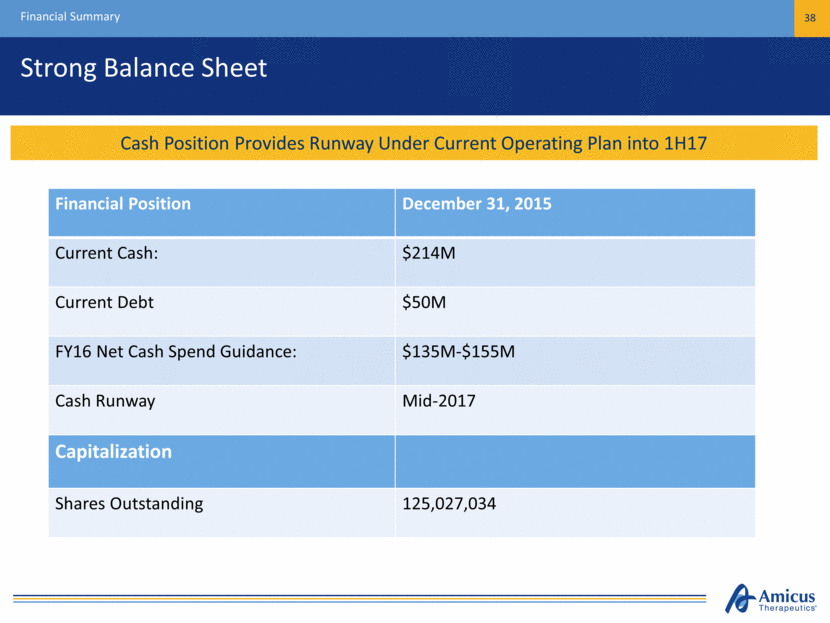
Key Drivers of Value Introduction 39 3 Novel Product Candidates Each with $500M to $1B+ Market Potential Migalastat Personalized Medicine (Small Molecule) MAA Submitted CHMP Opinion Anticipated Early 2016 Prepared for EU Launch* Phase 3 Novel Topical Cream (SD-101) U.S. Breakthrough Therapy Designation Rolling NDA Phase 3 Data Expected in 2H16 Novel ERT + Chaperone Treatment Paradigm Biologics Manufacturing Clinical Study Initiated with Data Anticipated in 2016 R&D Engine and Continued Business Development Activity Pompe Epidermolysis Bullosa (EB) Fabry *Pending Approval

Thank You ©AMICUS THERAPEUTICS. CRANBURY, NJ. January 2016.
